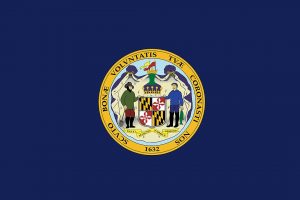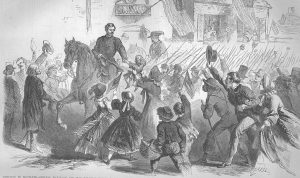To Spurn the Southern Scum? Union Soldier Motivation to Liberate Maryland in September 1862

Accounts abound of Union officers exhorting their men during the Battle of Gettysburg to fight ferociously as if the safety of their loved ones and their homes depended on it. On July 1, 1863, retreating Union cavalrymen passed through the ranks of the 97th New York Infantry and yelled, “There are no troops behind you! You stand alone, between the Rebel Army and your homes! Fight like hell!” Generals Abner Doubleday and Thomas Rowley reminded the men of the 150th Pennsylvania Infantry “that they were upon their own soil, that the eye of the commonwealth was upon them, and that there was every reason to believe they would do their duty to the uttermost in defence of their State.” The common soldier of the Army of the Potomac likely did not need these reminders of what was at stake fighting on Pennsylvania–and thus, Northern–soil, but officers attempted to squeeze every bit of motivation they could out of their men for the fight around Gettysburg.
Though it had its share of war detractors, Pennsylvania solidly remained a supporter of the Federal war effort. Its neighbor to the south, Maryland, however, repeatedly had (and still has) its loyalty to the United States during the Civil War questioned. While Union officers rallied their men to fight defiantly at Gettysburg because of Confederate troops in Pennsylvania, it appears that little of this occurred in September 1862 when Confederate forces marched on Maryland’s soil. Perhaps this was because of Maryland’s lukewarm allegiance to the United States. At least, such was the initial perception in the Federal ranks.
Though Maryland’s Legislature voted 53-13 against secession in April 1861, the state’s status during the war remained precarious. Confederate government officials believed they could entice Maryland into their nation. Slavery was still legal in the state in 1862. Additionally, some of the war’s first shots were fired in Baltimore’s streets when rioters attempted to block the passage of Union troops through that city en route to Washington.
Early in the Maryland Campaign, on September 8, Leo Faller of the 7th Pennsylvania Reserves wrote home:
I hope the Rebels will never get in to Pennsylvania for they would lay the Country as bare as a Desert and Pennsylvania would become like Virginia. Now is the time for every one who has a Single Spark of Patriotism in him to Volunteer for if the Rebels ever get into Pennsylvania, Cumberland County will be among the first to feel the Horrors of War and they will make Pennsylvania Suffer with a vengeance for the Rebels are terribly down on us for they think the troops from the gold Old Keystone State fight them harder than any other state troops.
The next day, he concluded his thoughts by noting a report of Confederate soldiers in Gettysburg. “[I]f that is the case,” Faller declared, “I wish they would send us there to fight them for I don’t want to see them stay in Pennsylvania.”
Keystone Stater George Cramer of the 11th Pennsylvania Infantry echoed a similar sentiment to his wife. Reflecting on the Maryland Campaign and his army’s recent performance in it, Cramer said that his comrades “fought with the last desperation to stop an invading foe from advancing on to their own fireside,” something echoed in the army’s feelings at Gettysburg. For Faller, Cramer, and likely for others, it became imperative to drive the enemy from Maryland’s soil in order to keep them out of Pennsylvania.
In the same letter, Cramer hinted at another factor urging the men of the Army of the Potomac to force the enemy south of the Potomac River. Aside from that outcome being viewed as a desperately needed victory, Federal soldiers wanted to show their fighting prowess. They believed the results of the Peninsula and Second Manassas campaigns did not reflect their true character and ability on the field. Cramer informed his wife, aside from protecting Pennsylvania from the enemy, his comrades at “the same time [wanted] to make good again that most shamefull [sic] defeat of Bull Run.”
Union soldier perceptions of Maryland’s shaky loyalty to the United States wore off throughout the campaign. They realized the land north of the Potomac River was different in many ways from Virginia on the south side of the river. “We find the country on this side of the Potomac in much better condition than the other,” wrote Pvt. William Brand of the 66th Ohio Infantry. “[F]arms are in fine order, teeming with full crops, and orchards full of the best fruits. The boys are not disposed to commit depredations as the citizens are very kind and sell them what they want at very low prices, compared with Virginia prices.” It was not just the landscape that won over the hearts and minds of the Army of the Potomac, however.
In nearly every central and western Maryland town that the Army of the Potomac passed through, citizens turned out to welcome the boys in blue. James Wren of the 48th Pennsylvania Infantry noted that the fine treatment the residents around Brookeville accorded the men of his regiment “made us feal [sic] as if we are near home…” Thomas Galwey, a sergeant in the 8th Ohio Infantry, noted similar sentiments expressed by Rockville’s citizens. “When we passed through Rockville, the inhabitants showed us great friendship, despite the fact that the rebels have been claiming that Maryland was one of their states, and only was waiting to be liberated by them.”

No doubt the best-recorded outpouring of Unionist sentiment during the Maryland Campaign came in the streets of Frederick from September 12-14 as the Army of the Potomac marched through the city. When the 1st Corps passed through Frederick on September 14, two days of passing Union troops had not yet exhausted the enthusiasm of Frederick’s citizens. The reception they received “filled every breast with emotion, the weight upon those backs grew light and the step more active,” wrote Lt. Sam Healy of the 56th Pennsylvania Infantry. “We could all see now something to fight for.”
Thus, it appears that Union soldier motivation early in the campaign to drive the enemy from Maryland’s soil stemmed more from a desire to protect their homes farther north and to redeem the recent Federal defeats in the Eastern Theater than from a desire to liberate Maryland. However, the reception Maryland’s loyal citizens gave each passing Union column altered Federal views of the state’s loyalty. Reflecting on the outcome of the campaign, Ohioan Charles Hay perhaps summed up this view best:
It is undeniable that the late rebel foray has benefitted us and our cause that it has demonstrated to traitors at home and abroad that Maryland is loyal and patriotic, and that our advent in her borders was welcomed as much as the minions of Secession were despised. Maryland has just passed through an “ordeal of fire,” and she has come out of it purer, and better, and firmer; and we all feel proud of her, and class her amongst the most loyal of States. Whatever doubt as to her integrity may have previously existed are now certainly dissipated. She has been “weighed and not found wanting.” Instead of the enemy receiving any “aid and comfort” from her, he has “gained nothing and suffered much.”
1 Response to To Spurn the Southern Scum? Union Soldier Motivation to Liberate Maryland in September 1862